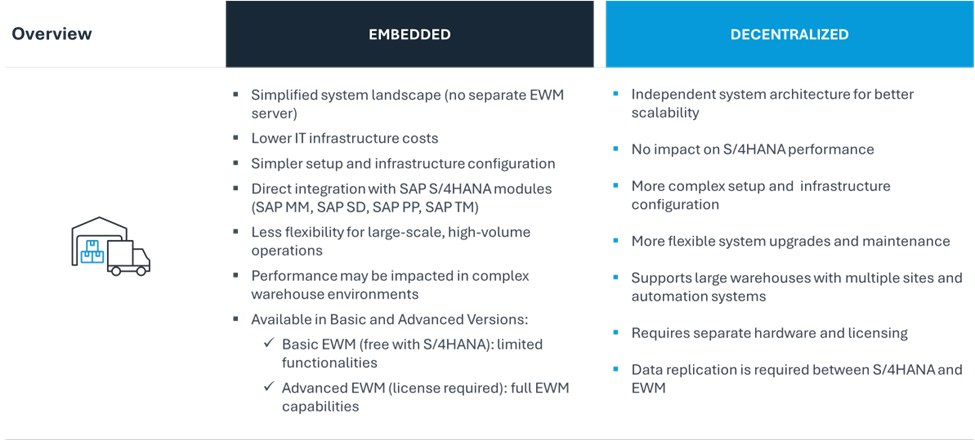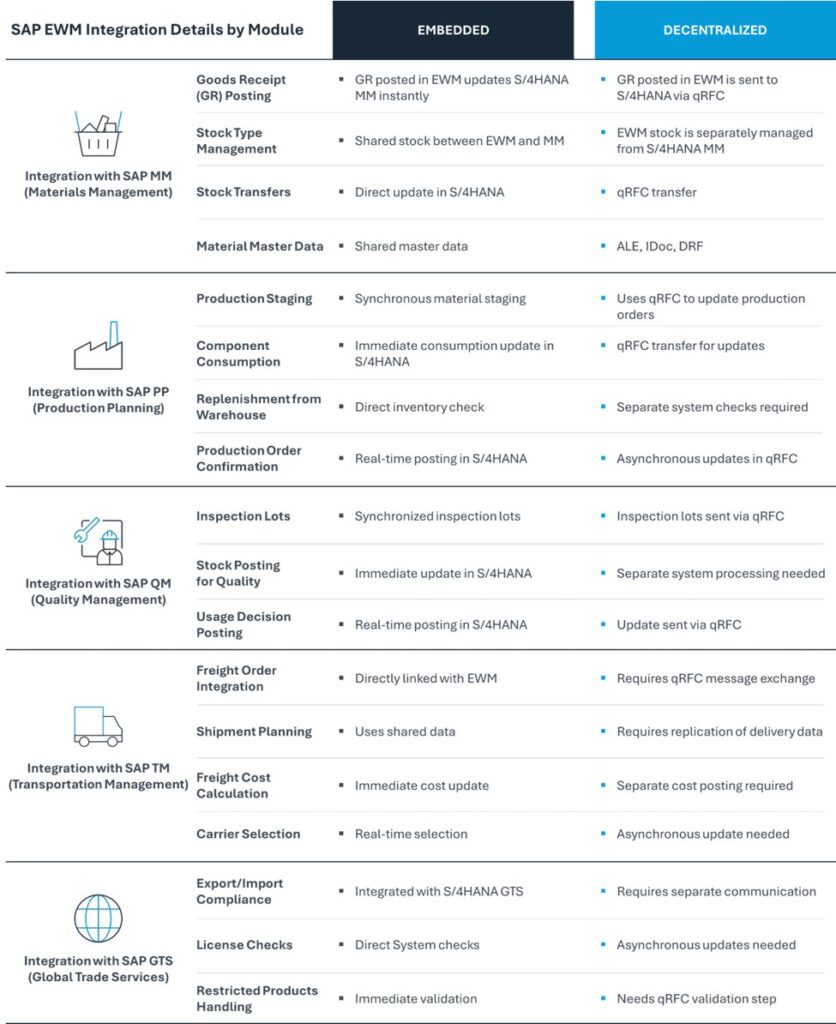Share this article
Follow us on Linkedin
What is the best approach to deploying EWM in an S/4 environment? Choosing the right SAP EWM deployment could make or break your efficiency. In this blog, we’ll break down embedded vs. decentralized EWM and help you determine the best fit for your business.
SAP EWM has many points to consider. Ensuring that your deployment method has the right handovers and communication points with each module is essential for smooth and lean enterprise processes and operations. In addition, choosing the most appropriate option for your business needs can significantly impact the flexibility and scalability of your digital infrastructure. Therefore, weighing the pros and cons of each alternative is a must.
When implementing SAP Extended Warehouse Management (EWM) with SAP S/4HANA, companies must consider several key integration aspects to ensure a seamless and efficient warehouse management process. In this article we will discuss system landscape and deployment options, integration topics such as master & transactional data, delivery & document flow synchronization, integration with other SAP modules, communication and middleware options, and performance and scalability considerations. Let’s dive in!
Which deployment method is right for you?
There are two deployment options to consider when choosing to implement EWM with S/4HANA: embedded EWM and decentralized EWM. If your goal is rapid implementation with minimal IT complexity and cost, embedded EWM is the way to go. It enables real-time inventory visibility, reducing processing delays and increasing operational efficiency—perfect for businesses with moderate warehouse needs.
To summarize, if EWM is connecting to one ERP system, warehouse operations are lower in volume, and there is little to no automation, then embedded EWM is the best option. With embedded EWM, you can choose to implement Basic EWM or Advanced EWM if you need advanced capabilities such as wave management, slotting, advanced production integration, etc. If EWM will connect in the future to multiple ERP systems, warehouse operations will be of higher volume, there’s higher automation, and advanced capabilities are needed, then decentralized EWM is the best option. Decentralized EWM on S/4HANA offers the best future scalability options, provides the best independent upgrade capabilities, and does not restrict future ERP integration scenarios. Similarly, if your current SAP landscape is using ECC, and you have a roadmap to transition to S/4HANA, but you want to start with modernizing your supply chain, then the best option is decentralized EWM.
How does EWM sync data with S/4HANA?
SAP EWM integrates with S/4HANA to manage warehouse operations efficiently. The integration ensures smooth data flow between the core ERP system (S/4HANA) and EWM, covering both master data and transactional data. Master data like product, warehouse structure, and business partners are synchronized. Transactional data flows between S/4HANA and EWM for deliveries, warehouse tasks, and stock updates. Embedded EWM has real-time integration and uses direct updates, while decentralized EWM utilizes Application Link Enabling (ALE), Intermediate Documents (IDoc), Data Replication Framework (DRF) and delivery replication for data exchange.
Why is delivery synchronization critical for smooth operations?
Delivery & document flow synchronization varies based on whether EWM is embedded in S/4HANA or decentralized EWM on S/4HANA. Here are some key differences to consider:
Data integration
- Embedded EWM uses direct table updates and synchronous processing while decentralized EWM uses qRFC, ALE, IDoc, DRF, and asynchronous updates.
Delivery processing
- Embedded EWM is faster with real time updates while decentralized EWM uses queued delivery replication.
Stock management
- Bin-level stock is managed in S/4HANA for embedded EWM, whereas EWM manages stock separately in Decentralized EWM.
Warehouse task execution
- In both systems, Warehouse Task execution happens in real time.
Goods issue/Goods receipt
- Goods Issue and Goods receipt postings are updated immediately in embedded EWM whereas decentralized EWM uses qRFC confirmation.
Integration with other SAP modules
SAP Extended Warehouse Management integrates with various SAP modules to streamline warehouse operations and ensure data consistency. The integration differs based on which deployment option you use.
Summary
To summarize, there are a lot of integration aspects to consider when choosing between embedded EWM or decentralized EWM with S/4HANA:
- Warehouse operations, cost, flexibility, and scalability.
- Synchronization requirements between S/4HANA and EWM.
- Integration between EWM and other SAP modules.
Embedded EWM is ideal for smaller operations, offers real-time data processing with lower latency, but scalability is limited by the resources of the S/4HANA system. High transaction volumes can result in performance bottlenecks. Decentralized EWM is better suited for large, high-volume warehouses, offering independent scalability for EWM and S/4HANA. It can handle complex and high-volume operations by leveraging qRFCs for asynchronous communication, though it introduces some latency.
Choosing the right SAP EWM deployment option for your business will make a significant impact to your overall supply chain. Though we covered several points in this article, there are still many more to consider when making this choice. To help you make a better decision to future-proof your warehousing operations, Westernacher’s extensive experience and proven expertise is here to support you every step of the way.
Let’s discuss how SAP EWM can transform your business. Book a 30-minute strategy session with our team now!
Let Westernacher Consulting help you unlock the full potential of SAP EWM and build a smarter, faster, and more profitable warehouse.
Contact us today to explore how we can support your warehouse transformation journey.



